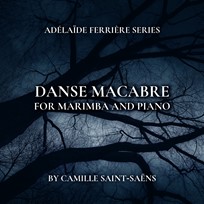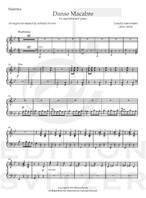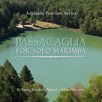
Danse Macabre
Composer: Camille Saint-Saëns
Instrument: Marimba and Piano
Level: Intermediate/Advanced
Published: 2019
Price: €25.00
Item details
-
Description +
-
Duration. approx. 7 min.
Arranged and adapted by Adélaïde Ferrière
The well known symphonic poem 'Danse Macabre', originally written in its orchestral version, was also arranged by the composer for two pianos.
That gave me the idea to arrange the work with the marimba instead of the piano as a keyboard duo.
Part of this work was reduced for the first piano part in order for the arrangement to be playable without losing too many information from the original musical text.
Sometimes, I had to reverse the two parts when the text was too dense to be played on the marimba, so marimba played the second piano.
This duo works pretty well in the spirit of this skeleton Danse, imitating the bones noise, advancing the piano in this continuous waltz.
-
-
Instrumentation +
-
Marimba and Piano
-
-
Watch+
-
Performed by Adélaïde Ferrière (Marimba) & Matthieu Cognet (Piano)
Performed by Adélaïde Ferrière (Marimba) & Fanny Azzuro (Piano)
-
-
About the composer +
-
Charles-Camille Saint-Saëns (9 October 1835 – 16 December 1921) was a French composer, organist, conductor and pianist of the Romantic era. His best-known works include Introduction and Rondo Capriccioso (1863), the Second Piano Concerto (1868), the First Cello Concerto (1872), Danse macabre (1874), the opera Samson and Delilah (1877), the Third Violin Concerto (1880), the Third ("Organ") Symphony (1886) and The Carnival of the Animals (1886).
-
-
Reviews +
-
Review (Percussive Notes, June 2020)
Taking inspiration from the two piano arrangement of the famous symphonic poem (both done by Camille Saint-Saëns), this arrangement for marimba and piano mixes elements of the two-piano version in order to create a new version that is idiomatic to the marimba while keeping the same character of the original work.
The marimba part is adapted from both the first and second piano parts at times. From a technical standpoint, it is relatively idiomatic. While advanced four-mallet technique isn’t often used in the work, players will need to be comfortable with one-handed rolls as well as performing some brisk two-mallet runs while holding four mallets. The arranger has done a good job of maintaining many of the original articulations and phrase indicators, including some such as mordents, which are not terribly common in percussion music, giving students and teachers an opportunity to examine common articulation symbols from other instruments.
This piece would be appropriate for an undergraduate recital. It affords many musical, as well as historic educational, opportunities. At just over seven minutes long, performers and listeners would gain much from experiencing this arrangement of a classic work.
—Brian Nozny
-
-
Credits +
-
Front Cover Design: Gaia Gomes
Photo: Adrien Roux
Engraving: Adélaïde Ferrière
Printed in Copenhagen, Denmark
www.editionsvitzer.com
-




